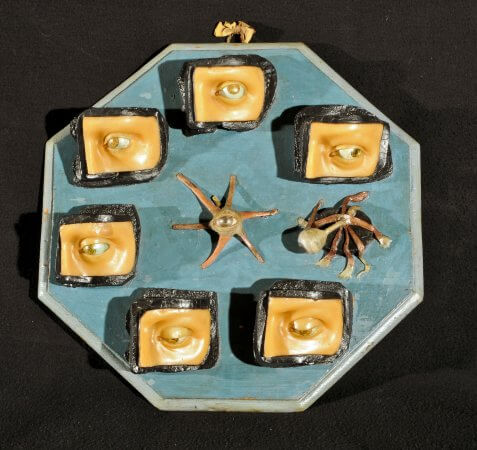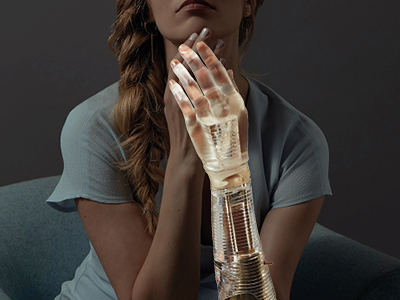The Lady Anatomist Anna Morandi Manzolini
Muscoli estrinseci dell’occhio (Extrinsic ocular muscles), 18th c. (1755–1769)
Anatomical model made of painted wax, wood, fabric
35 x 35 x 7 cm
Courtesy Alma Mater Studiorum – University of Bologna | University Museum Network | Museum of Palazzo Poggi
The sense of sight has always held a unique significance for human beings. It is a vital faculty of the body, enabling it to engage with the outside world. Vision shapes the perception of reality and, in turn, generates words and images through which the world is grasped. The word ‘theory’ derives from the ancient Greek verb theorein, meaning ‘to look at’ or ‘to observe’. The history of vision is closely intertwined with the history of science, philosophy and art. In antiquity, it was believed that the eye emitted visual rays, or alternatively, that objects released images which the eye received. It was only Leonardo da Vinci who, through his anatomical dissections, recognised the structure and functioning of the eye.
And therefore, the anatomical model of the ocular muscles, from the Museum of Palazzo Poggi’s collection in Bologna, occupies a significant place in the history of knowledge concerning the human apparatus of perception. Its creator was Anna Morandi Manzolini (1714–1774), both an anatomist and artist, who worked in Bologna together with her husband, Giovanni Manzolini (1700–1755). After his death, Anna Morandi Manzolini continued the work on her own. Trained as a painter and sculptor, she wove art and anatomy into a single practice. At a time when women were scarcely visible in either discipline, she was a striking exception.
Unlike what was customary at the time, the Morandi Manzolini couple did not represent whole bodies in wax. Instead, they developed their own method, focusing on individual organ systems. These were removed, dissected and then modelled in wax. The result was highly detailed models of single organs, created for the training of medical practitioners and anatomists. In doing so, they dispensed with any iconographic or allegorical embellishments.
Anna Morandi Manzolini’s meticulous autopsy of thousands of bodies led to numerous new insights and the correction of several long-standing misconceptions. To each of her models she added a precise description of the structures and their functions. She always began with exact observation, followed by dissection. The manual process was then accompanied by the written word—a description of what the hand had explored. This method continues to be applied in medical training today. After the written word came the image, shaped in wax.
Sight and touch were her most important tools of knowledge. It may be no coincidence that she devoted her greatest interest precisely to the sensory organs, observes art historian Prof. Lucia Corrain of the Museum of Palazzo Poggi. The University of Bologna holds a 250-page manuscript by Anna Morandi Manzolini containing instructions, notes and descriptions.
An example of her masterful wax modelling is the series of blue, octagonal wooden panels on which Anna Morandi Manzolini depicted an eye in different stages of anatomical separation of tissue layers. On the model Muscoli estrinseci dell’occhio (Extrinsic ocular muscles), the vitreous body of an eye is shown at the centre, exposed together with its various muscles, and their attachments spread out like the arms of a starfish. Surrounding it, six eyes demonstrate the different movements enabled by these muscles, and to the right, another eye is displayed, opened to reveal the optic nerve.
The workshop for wax modelling in Bologna was the first of its kind. From here, this innovative craft, serving both scientific inquiry and visualisation, spread first to Florence and then across Europe. Pope Benedict XIV endowed the anatomical cabinet in which the Morandi Manzolini couple worked until they established their own laboratory. Anna Morandi Manzolini’s works in particular attracted the attention of princely courts, academies and learned societies throughout Europe. Yet she remained in Bologna.
As an honorary professor at the Istituto delle Scienze, she was regarded as the most important wax modeller of her time. Yet she was not spared the gender inequalities of her age. She received less pay than her male colleagues and, as her biographer Rebecca Messbarger emphasises, was often depicted in later sources merely as her husband’s assistant.
Her self-portrait in wax can also be seen at the Museum of Palazzo Poggi and stands alongside the portrait of her husband. Unlike the usual representations of women in anatomical wax figures—as a dead body, a shamed Eve, or a sexualised Venus—Anna Morandi Manzolini depicts herself in aristocratic dress, guiding a scalpel across a human brain. In doing so, she deliberately presents herself on an equal footing with her husband, who, in the companion piece, is shown dissecting a heart.


